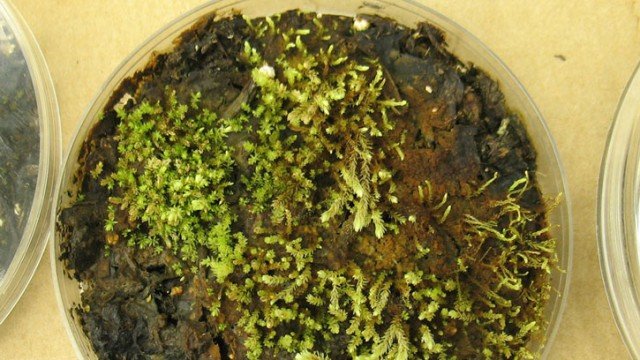Scientists have announced that plants that were frozen during the “Little Ice Age” centuries ago have been observed sprouting new growth.
Samples of 400-year-old plants known as bryophytes have flourished under laboratory conditions.
Researchers say this back-from-the-dead trick has implications for how ecosystems recover from the planet’s cyclic long periods of ice coverage.
The findings appear in Proceedings of the National Academy of Sciences.
They come from a group from the University of Alberta, who were exploring an area around the Teardrop Glacier, high in the Canadian Arctic.
The glaciers in the region have been receding at rates that have sharply accelerated since 2004, at about 3-4 m per year.
That is exposing land that has not seen light of day since the so-called Little Ice Age, a widespread climatic cooling that ran roughly from AD 1550 to AD 1850.
“We ended up walking along the edge of the glacier margin and we saw these huge populations coming out from underneath the glacier that seemed to have a greenish tint,” said Catherine La Farge, lead author of the study.

Samples of 400-year-old plants known as bryophytes have flourished under laboratory conditions
Bryophytes are different from the land plants that we know best, in that they do not have vascular tissue that helps pump fluids around different parts of the organism.
They can survive being completely desiccated in long Arctic winters, returning to growth in warmer times, but Dr. Catherine La Farge was surprised by an emergence of bryophytes that had been buried under ice for so long.
“When we looked at them in detail and brought them to the lab, I could see some of the stems actually had new growth of green lateral branches, and that said to me that these guys are regenerating in the field, and that blew my mind,” she said.
“If you think of ice sheets covering the landscape, we’ve always thought that plants have to come in from refugia around the margins of an ice system, never considering land plants as coming out from underneath a glacier.”
But the retreating ice at Sverdrup Pass, where the Teardrop Glacier is located, is uncovering an array of life, including cyanobacteria and green terrestrial algae. Many of the species spotted there are entirely new to science.
“It’s a whole world of what’s coming out from underneath the glaciers that really needs to be studied,” Dr. Catherine La Farge said.
“The glaciers are disappearing pretty fast – they’re going to expose all this terrestrial vegetation, and that’s going to have a big impact.”
A new study shows that during medieval times the whole of our planet heated up without the aid of human CO2 emissions.
Earth then cooled down naturally and there was even a “mini ice age”.
A team of scientists led by geochemist Zunli Lu from Syracuse University in New York state, has found that contrary to the “consensus”, the “Medieval Warm Period” approximately 500 to 1,000 years ago wasn’t just confined to Europe.
In fact, it extended all the way down to Antarctica – which means that the Earth has already experience global warming without the aid of human CO2 emissions.
At present the Intergovernmental Panel on Climate Change (IPCC) argues that the Medieval Warm Period was confined to Europe – therefore that the warming we’re experiencing now is a man-made phenomenon.
However, Prof. Zunli Lu has shown that this isn’t true – and the evidence lies with a rare mineral called ikaite, which forms in cold waters.
“Ikaite is an icy version of limestone,” said Prof. Zunli Lu.
“The crystals are only stable under cold conditions and actually melt at room temperature.”
It turns out the water that holds the crystal structure together – called the hydration water – traps information about temperatures present when the crystals formed.
This finding by Prof. Zunli Lu’s research team establishes, for the first time, ikaite as a reliable way to study past climate conditions.
The scientists studied ikaite crystals from sediment cores drilled off the coast of Antarctica. The sediment layers were deposited over 2,000 years.

The Medieval Warm Period extended all the way down to Antarctica, which means that the Earth has already experience global warming without the aid of human CO2 emissions
The scientists were particularly interested in crystals found in layers deposited during the “Little Ice Age”, approximately 300 to 500 years ago, and during the Medieval Warm Period before it.
Both climate events have been documented in Northern Europe, but studies have been inconclusive as to whether the conditions in Northern Europe extended to Antarctica.
Prof. Zunli Lu’s team found that in fact, they did.
They were able to deduce this by studying the amount of heavy oxygen isotopes found in the crystals.
During cool periods there are lots, during warm periods there aren’t.
“We showed that the Northern European climate events influenced climate conditions in Antarctica,” Prof. Zunli Lu says.
“More importantly, we are extremely happy to figure out how to get a climate signal out of this peculiar mineral. A new proxy is always welcome when studying past climate changes.”
The research was recently published online in the journal Earth And Planetary Science Letters and will appear in print on April 1.


